Xiaowutai Jinhe Scenic Area is located in Yuxian County, Zhangjiakou City, Hebei Province. It is an important part of Xiaowutai Mountain National Nature Reserve and a national 4A-level tourist attraction. The scenic area is famous for its unique mountain scenery, rich biodiversity, and profound historical and cultural heritage. Inside the scenic area, there are high mountains and dense forests, with gurgling streams. It has rare primary secondary forests in North China, with a vegetation coverage rate of over 90%. The total area of the scenic area is about 10 square kilometers, of which the core scenic area is about 5 square kilometers. The highest peak in the area, Dongtai, is 2882 meters above sea level, making it the second highest peak in North China. Most of the buildings in the scenic area are antique buildings integrated with the natural landscape, such as pavilions and plank roads, with a total construction area of about 1500 square meters, which not only facilitates tourists' visits but also does not damage the overall natural style.
Historical Culture
The Xiaowutai Mountain area where Xiaowutai Jinhe Scenic Area is located has a long history. There have been traces of human activities as early as the Neolithic Age. Many Neolithic sites have been found in and around the scenic area, and a large number of cultural relics such as pottery and stone tools have been unearthed, witnessing the life and reproduction of early humans here.
In history, Xiaowutai Mountain was an important place for Buddhist and Taoist activities, leaving many religious and cultural relics. According to historical records, monks built temples here to promote Buddhism during the Tang Dynasty. Some existing temple sites in the scenic area, such as the Jinhe Temple Site, though having gone through vicissitudes, still show the scale and pattern of that time, attracting many religious culture lovers and historical researchers to explore.
In addition, the Xiaowutai Mountain area is also an old revolutionary base. During the War of Resistance against Japanese Aggression, it was an important part of the Jin-Cha-Ji Anti-Japanese Base Area. Countless revolutionary martyrs fought arduously here, leaving many heroic deeds that are both praiseworthy and moving, adding a strong red cultural heritage to the scenic area.
Main Attractions
Yixiantian (One-Line Sky)
Yixiantian is located in the northern part of the scenic area. It is a naturally formed canyon landscape. The canyon is about 200 meters long, and the narrowest part is only 1.5 meters. The stone walls on both sides are steep, up to tens of meters high. Looking up, you can only see a line of sky, hence the name. Walking through Yixiantian, you can feel the uncanny workmanship of nature. There are many inscriptions by literati of past dynasties on the stone walls, which have certain cultural value.
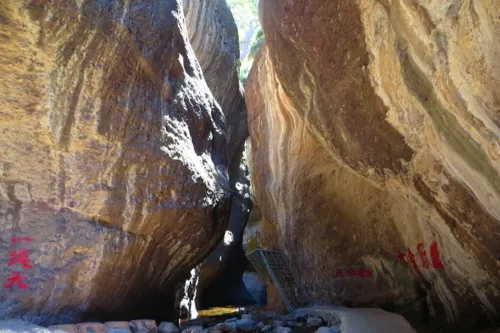
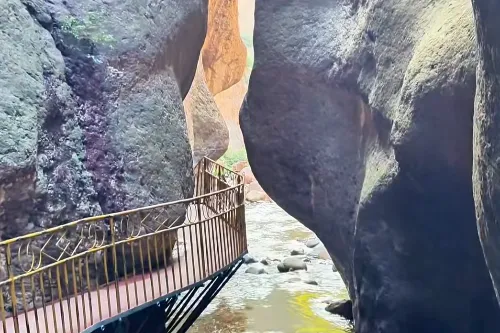
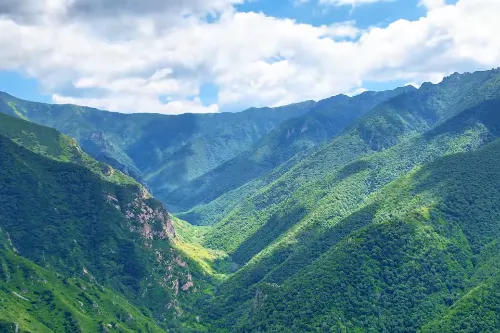
Zhenyaoshi (Demon-Suppressing Stone)
It is about 5 meters high and nearly 8 meters wide, with an irregular cuboid shape overall. Its surface is covered with vigorous veins, as if carved by thousands of years of wind and rain. Legend has it that this stone fell from the sky in ancient times to suppress the goblins in the mountains. A trace similar to a spell formed naturally can be vaguely seen on one side of the stone, adding a mysterious color to it. Zhenyaoshi is surrounded by forests, forming a delightful contrast with the surrounding canyons and streams. It is not only a natural landscape full of fantasy in the scenic area but also a characteristic check-in spot for tourists to stop and explore and take photos because of the folk legend.
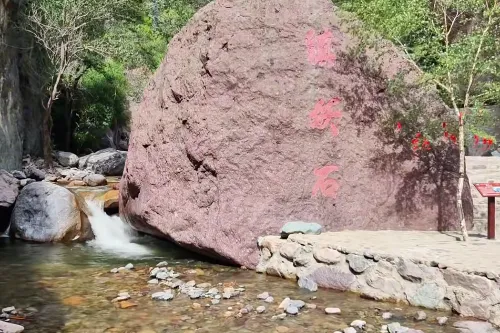
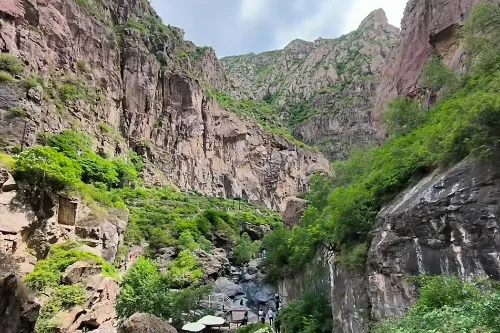
Hamatou (Toad Head)
Hamatou in Xiaowutai Jinhe Scenic Area is the first scenic spot when entering the scenic area. It is a stone with a low cliff, shaped like a toad drinking water by the river. From different angles, some people think it looks like a conch cover, a shell, or a steamed bun. This unique stone, with its lifelike shape, adds a natural interest to the scenic area, attracting tourists to stop and watch and take photos.
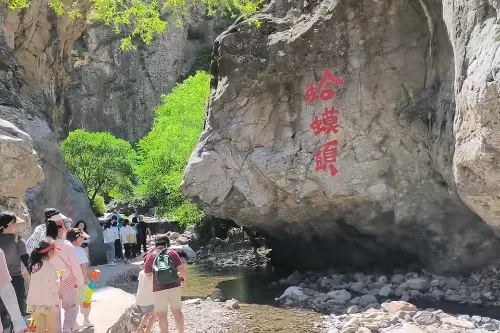

Jinhe Temple
Jinhe Temple was built in the Tang Dynasty and was once an influential Buddhist temple within a radius of a hundred miles. At its peak, the temple covered an area of about 5000 square meters, with scattered halls and monk's quarters, and a large number of monks, with a thriving incense. On the existing site, there are still some remains such as broken walls, ancient steles, stone carvings, and column bases, which silently tell the glory of the past. The temple is located among green mountains and clear waters, surrounded by green ancient cypresses, with a quiet environment. Although it has gone through vicissitudes, it still exudes a strong historical and religious cultural atmosphere, making it an important place for tourists to explore ancient relics and feel the precipitation of time.
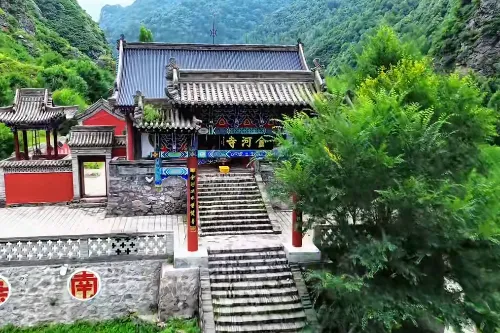
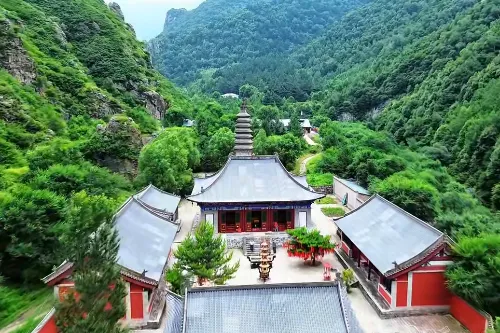
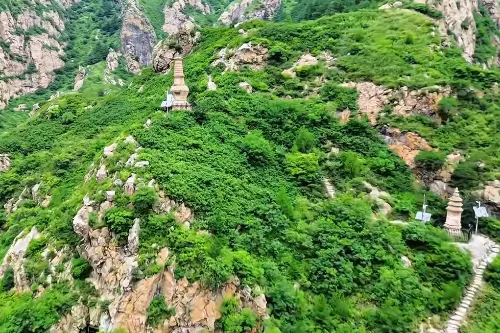
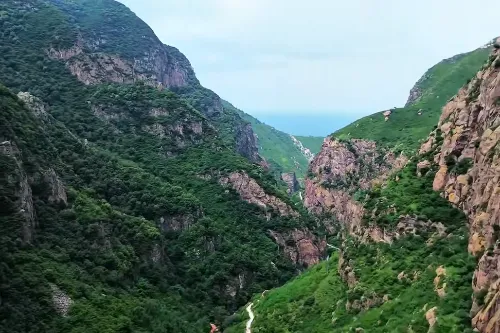
Tour Route
Scenic Area Entrance → Hamitou → Qingliang Valley → Zhenyaoshi → Xianshuishi → Yixiantian → Shenlongtan → Tongtiandong → Xiulubei → Hongxiagu → Miquan → Talin → Jinhe Temple → Jinhe Temple Site → Suspension Bridge. This route allows tourists to enjoy most of the scenic spots in the scenic area and feel the natural scenery and historical culture of Jinhe Scenic Area. When you reach the suspension bridge, you are at the end of the scenic area, and then you can return along the original road.
Tour Suggestions
- The hiking route in the scenic area is relatively long. It is recommended to wear comfortable sports shoes and sportswear to reduce fatigue.
- Due to the high altitude in the scenic area, the temperature changes greatly. Even in summer, it is necessary to carry a coat to prevent catching a cold.
- A lot of physical strength is consumed during the tour. It is recommended to carry enough drinking water and dry food. There are also a few small stores in the scenic area, but the prices are relatively high.
- The natural landscape in the scenic area is beautiful. It is recommended to carry a camera or mobile phone to record the beautiful moments.
- The best tourist seasons are summer (June-August) and autumn (September-October). You can avoid the heat in summer and enjoy red leaves in autumn. It is recommended to visit for 1-2 days.
- If you plan to climb Dongtai, it is recommended to check the weather in advance and avoid rainy or windy days to ensure safety.
- There are camping areas in the scenic area. If you want to experience camping, you need to prepare camping equipment in advance and abide by the camping regulations of the scenic area.
Matters Needing Attention
- The scenic area is a national nature reserve. It is strictly forbidden to damage vegetation, pick flowers and plants, catch wild animals, etc. Violators will be punished accordingly.
- Some sections in the scenic area are steep. During the tour, please pay attention to safety and do not leave the designated route without permission to prevent getting lost or accidents.
- Smoking and using open flames in the scenic area are prohibited to prevent forest fires.
- Take good care of the environment of the scenic area. Do not litter. Put garbage into the designated trash cans.
- If you feel unwell or encounter an emergency during the hike, you can call the scenic area's rescue phone. There are multiple emergency rescue points in the scenic area.
- Respect the local customs and religious beliefs. Keep quiet in places such as temple sites and do not touch cultural relics at will.
- Mobile phone signals are weak in some areas of the scenic area. It is recommended to agree on the gathering time and place with your companions in advance to avoid getting separated.
Transportation
- Self-driving: Starting from Beijing, take the Jingzang Expressway → Xuanda Expressway → exit at Yuxian East, then drive about 30 kilometers along the signs to reach the scenic area. The whole journey is about 300 kilometers, and the driving time is about 4.5 hours. Starting from Zhangjiakou City, take the Zhangshi Expressway → Xuanda Expressway → exit at Yuxian East, then drive about 30 kilometers to reach the scenic area. The whole journey is about 150 kilometers, and the driving time is about 2.5 hours.
- Public transportation: There are buses from Yuxian County to the scenic area, with one bus at 8:00 and 10:00 every morning, and return trips at 14:00 and 16:00 in the afternoon. The driving time is about 1 hour, and the ticket price is about 20 yuan per person. You can take a bus from Zhangjiakou Bus Station to Yuxian County, and then transfer to a bus to the scenic area after arriving in Yuxian County.
- Taxi: Taking a taxi from Yuxian County to the scenic area costs about 80-100 yuan, and the driving time is about 1 hour.
Opening Hours
The opening hours will be adjusted according to the season. In summer (April 1st - October 31st), the opening hours are 7:00-18:00; in winter (November 1st - March 31st of the next year), some areas are closed, and the opening hours of the open areas are 8:00-17:00. The scenic area will maintain some sections from December to February every year, which may affect normal visits. It is recommended to check the official information of the scenic area in advance before traveling.
Tickets
As of August 20, 2025, the ticket price is 68 yuan per person. You can search for the official WeChat account "小五台金河景区" to get the latest updates.
Online Booking
Click here to jump to the Trip.com ticketing platform for ticket purchase.
